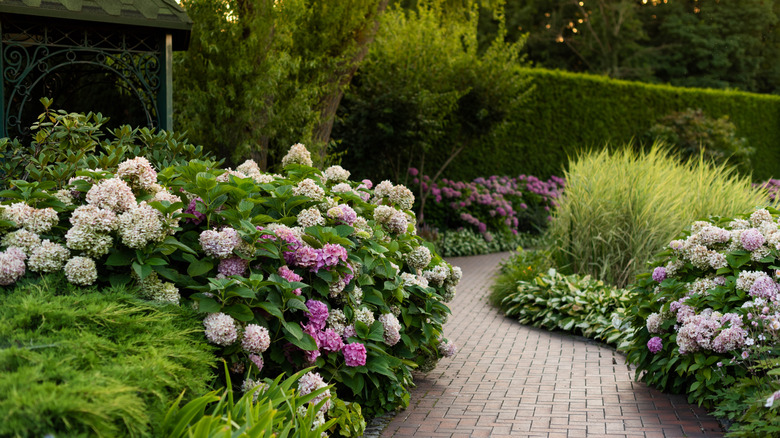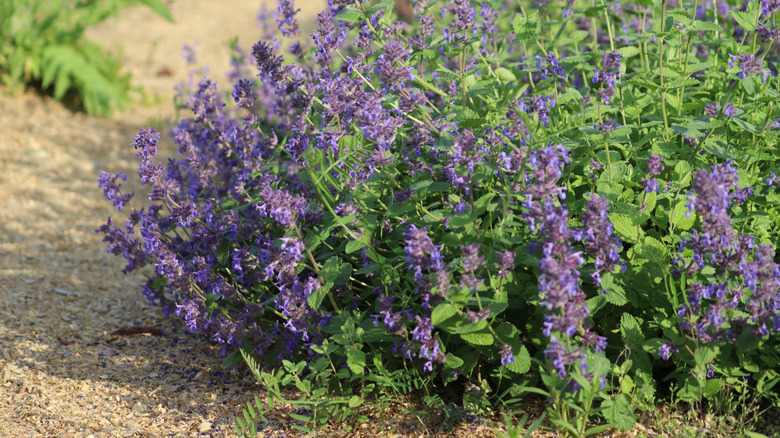Plant One Fast-Growing Ground Cover Under Hydrangeas For A Showstopping Garden Of Color
Sprawling hydrangeas are a garden staple for a reason: They're vibrant, elegant, and command attention with their oversized blooms. But even the star of the show could use a little support every now and then. That's where ground covers comes in. With the right plant at their feet, the entire bed can feel lush, layered, and intentionally designed. If you've been on the hunt for the perfect companion plants for your hydrangea bushes that integrate some additional color into your garden, your search may have come to an end. One option that stands out among the rest is catmint (Nepeta racemosa). This hearty, fast-growing ground cover offers a stunning contrast to hydrangeas, weaving a soft lavender-blue carpet beneath their voluminous flowers. Its silvery-green foliage and light blossoms create depth and movement, turning an ordinary garden bed into a layered masterpiece. The effect is natural yet sophisticated — adding a touch of wilderness that's simultaneously refined.
But, catmint itself brings more to the table than just looks. It's an ideal companion plant for hydrangeas because they both thrive in similar conditions. Catmint loves well-draining soil and partial shade, perfect for nestling under a sprawling hydrangea bush that enjoys the same type of soil. And, while hydrangeas may take centerstage around your garden, catmint can provide delicate flowers at times when your bushes may not be at their peak. It can bloom for months, helping your garden feel full and lush throughout the seasons. Catmint typically flowers between late spring and fall. Even better, it offers a host of potential benefits: Attracting pollinators like butterflies and bees, helping to suppress weeds, and deterring pests like rabbits or deer.
Growing catmint under hydrangeas along with other companion plants
Planting catmint around the home is a favorite among beginner and seasoned gardeners, as it's fairly easy to maintain. You'll want to start by choosing the right spot near your hydrangeas, providing particle shade or full sun. The soil should be well-draining, as catmint doesn't handle soggy roots well. You should try to set catmint plants about 18 inches apart from one another, especially if you're using multiples. Catmint will need to be watered fairly deeply once it is first planted to allow the roots to establish. Be mindful of how quickly catmint plants can grow, as they can easily overtake your garden. Prune them back after the first bloom in the summer to keep their growth under control. Growing this aromatic plant around your garden can help keep pesky weeds out, too.
Looking to diversify your planting even further? Catmint pairs beautifully with other low-growing ground covers that share similar care needs. Consider lamb's ear (Stachys byzantina) for its velvety, silver leaves that contrast against catmint's delicate blooms. Creeping thyme (Thymus serpyllum) is another excellent option, adding texture, fragrance, and even edible benefits without over competing for space. For a pop of additional color, lady's mantles (Alchemilla mollis) work wonderfully, while hardy geraniums can mirror your hydrangeas with whites, pinks, and purples. When mixing companion plants, you'll want to be mindful of spacing as fast-growing ground covers like catmint, need a little breathing room to avoid crowding out more delicate species. With thoughtful planning, you can easily grow and care for your hydrangeas, creating a lush and fragrant garden scape straight out of a fairytale.

